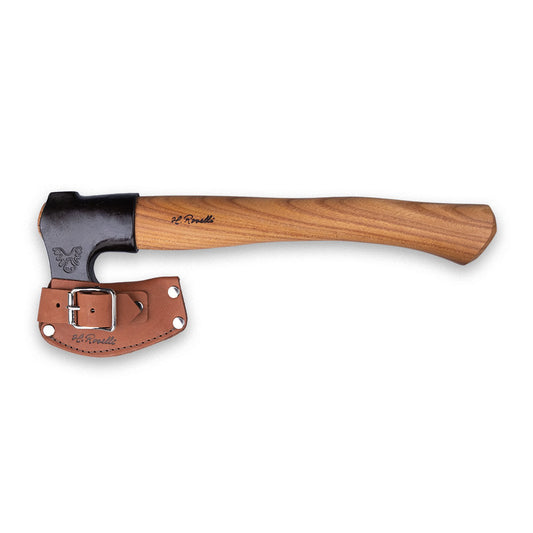Conoce a Engin, nuestro embajador de confianza de Roselli, un nombre que resuena profundamente en el mundo de los entusiastas y aventureros al aire libre.
Como profesional del bushcraft y figura destacada en la comunidad de actividades al aire libre, Engin aporta una gran experiencia, conocimiento y una pasión inigualable por la naturaleza. Ahora está aquí para compartir su experiencia sobre cómo acampar como un profesional en una temporada en la que las hojas están cayendo.
Dormir y ropa
En las noches frescas de otoño, no es raro quedarse dormido sintiéndote cálido después de un día lleno de actividad física. Pero, lamentablemente, generalmente no es igual de cálido cuando te despiertas. Aquí tienes algunos consejos sobre cómo empacar tu ropa y equipo para dormir:
- Llevar un juego extra de ropa interior térmica de lana merino seca y un segundo par de calcetines dentro del saco de dormir hará maravillas.
- También deberías considerar dormir con tu ropa puesta dentro del saco de dormir.
- Si no quieres dormir con la ropa puesta, esto es lo que me ha funcionado: tan pronto como te despiertes, mete la ropa que piensas usar durante el día dentro del saco de dormir. Quédate dentro del saco junto con la ropa durante unos minutos para que absorba algo del calor retenido durante la noche. ¡Estará cálida y agradable cuando te la pongas!
- Evita respirar dentro del saco de dormir en otoño. Esto genera humedad y puede arruinar tu experiencia. Mantén tu boca o incluso tu cabeza fuera del saco de dormir. Si tu cabeza está fría, usa un pasamontañas para retener el calor corporal. Esto mantendrá tanto tu cabeza como tu cuerpo cálidos.
- Oblígate a ir al baño antes de meterte en el saco de dormir. Como siempre te decía tu madre, incluso si crees que no lo necesitas, ¡hazlo! Especialmente si tienes mi edad o más (mayor de 40 años). Lo último que querrás hacer en medio de una fría noche es salir de tu cálido saco de dormir para vaciar la vejiga y congelarte.
Cocinar sobre un fuego abierto en lugar de una cocina a gas puede despertar tu espíritu y hacer que la experiencia al aire libre en otoño sea aún más intensa. El calor de un pequeño fuego tampoco debe ser subestimado. Incluso si has revisado el pronóstico del tiempo y elegido el día más seco, hay una buena probabilidad de que llueva en algún momento. Siempre es una buena idea llevar una lona y aprender a montar diferentes tipos de refugios. No solo te mantendrá seco, sino que es aún más genial poder tener un fuego en la lluvia. Todo lo que debes hacer es estirar la lona sobre la fogata, lo suficientemente alta para que no se caliente demasiado y las llamas no la alcancen.
He hecho esto varias veces y he tenido experiencias maravillosas durante la temporada de lluvias en la Laponia Finlandesa. A veces incluso usé un poncho de lluvia como lona.
Consejos adicionales
Aquí tienes algunos consejos adicionales para acampar y hacer senderismo durante las estaciones de otoño e invierno:
Seguridad con el fuego: aunque las fogatas son acogedoras, asegúrate de seguir las regulaciones locales sobre el fuego. Algunas áreas pueden restringir las fogatas en otoño debido al aumento del riesgo de incendios. Siempre lleva una estufa portátil de camping como respaldo para cocinar.
Gestión del agua: las fuentes de agua pueden ser más escasas en otoño, así que planifica tu suministro de agua en consecuencia. Lleva un filtro de agua o tabletas de purificación para depurar agua de fuentes naturales. También lleva una botella de agua aislada para que el agua no se enfríe demasiado en el clima fresco.
Precauciones con la fauna: el otoño es la temporada de apareamiento y migración para muchos animales salvajes. Ten cuidado con los osos guardando bien tu comida y utilizando canisters o bolsas para osos. Usa campanas para osos para alertar a los animales de tu presencia y reducir la probabilidad de encuentros inesperados.
Bolsas impermeables adicionales: protege tu equipo de la lluvia con bolsas impermeables o bolsas secas. Esto es especialmente importante para los electrónicos, ropa de repuesto y tu saco de dormir.
No dejar rastro: el otoño es una época sensible para los ecosistemas, ya que se preparan para el invierno. Quédate en senderos pavimentados, evita pisotear vegetación sensible y lleva contigo tu basura.
Comunicación de emergencia: lleva un teléfono móvil completamente cargado o un dispositivo de comunicación por satélite en caso de emergencia. Siempre es mejor tener un medio de comunicación confiable en caso de que las cosas no salgan según lo planeado. Si viajas solo, TIENES QUE avisar a alguien sobre tu destino y la hora en que regresarás. ¡Esto puede salvar tu vida!
Siguiendo estos consejos adicionales, estarás bien preparado para una aventura de camping y senderismo memorable y segura en otoño. ¡Disfruta de los impresionantes colores y del aire fresco de esta época del año!
/ Engin















